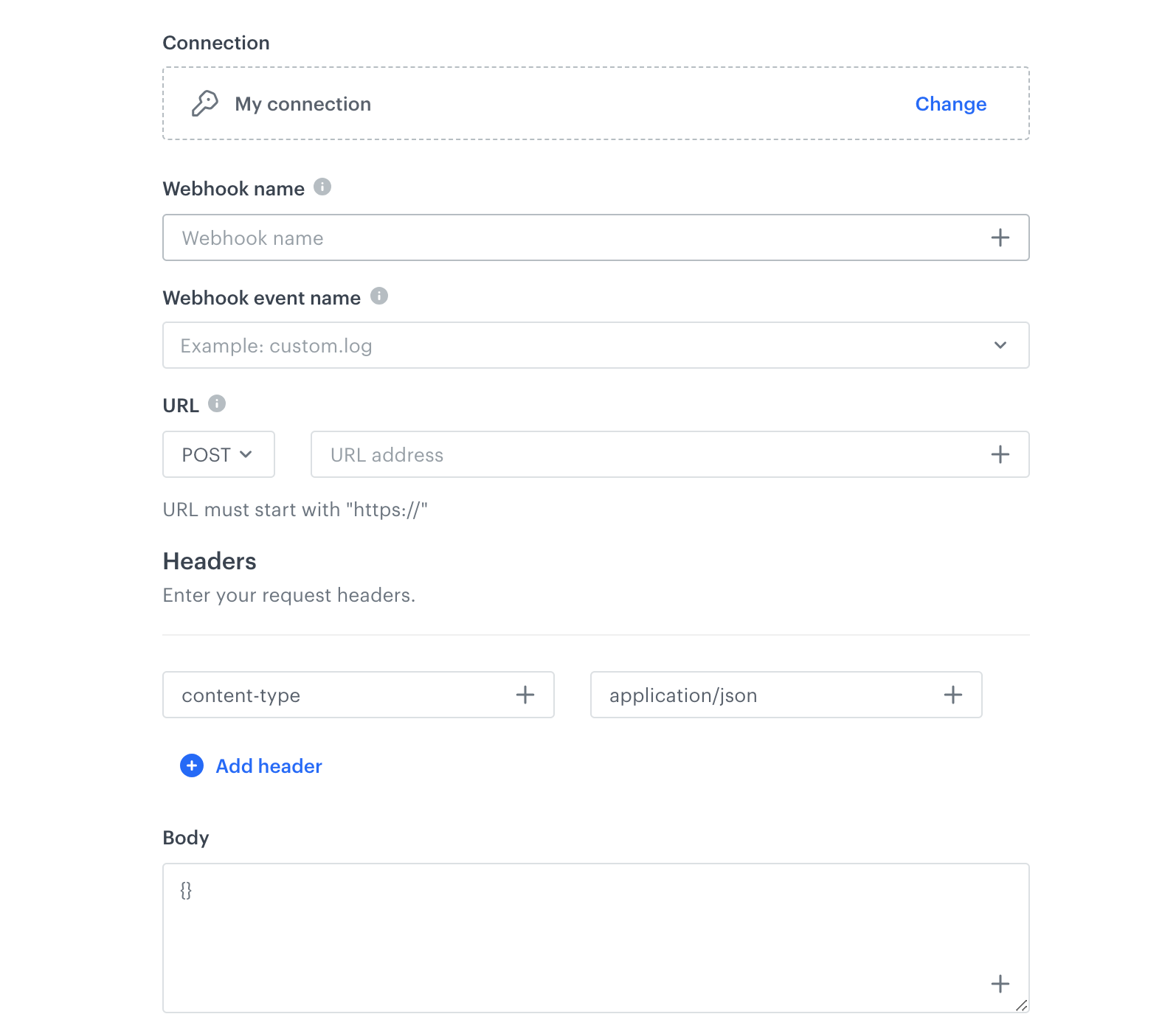Outgoing integration node
This action allows you to send requests from Synerise to external systems. This node can reuse existing outgoing integrations or you can define a custom webhook that is configurable only in a specific workflow and node.
Node configuration
Select outgoing integration type
- Click the pencil icon on the node.
- Select the type of the Outgoing integration.
- Integrations - If you prepared an outgoing integration earlier, you can use this option.
- From the dropdown list, select the outgoing integration prepared earlier.
- Confirm with the Apply button.
- Custom webhook - Use this option if you want to create outgoing integration from scratch.
- Integrations - If you prepared an outgoing integration earlier, you can use this option.
Set up a connection
In this part of the process, you must define how you access your source. By selecting the authentication method and providing the required information, you establish a connection.
1.On the pop-up, select the authentication method:
- No authentication - No authentication is required.
- Password - Authentication is based on a log-in and a password to a resource.
Click here to see the instructions
- Click Select connection.
- In the connection list:
- If the connection you want to use is in the list, select it and proceed to Filling out the configuration form.
- If the connection list is empty or you don’t see a connection you need to use:
- At the bottom of the dropdown list, click Add connection.
- In the Connection name field, enter the name of your connection (it’s visible only on the Select connection dropdown list).
- In the Login field, enter a log-in.
- In the Password field, enter the password.
- Click Save.
The connection you created is saved and can be used later in other nodes and workflows.
- Token - This method allows you to authenticate by a token.
Click here to see the instructions
- Click Select connection.
- If the connection you want to use is in the list, select it and proceed to Filling out the configuration form.
- If the connection list is empty or you don’t see a connection you need to use:
- At the bottom of the dropdown list, click Add connection.
- In the Connection name field, enter the name of your connection (it’s visible only on the Select connection dropdown list).
- In the Token field, enter a token.
- Click Save.
The connection you created can be used later in other nodes and workflows.
- If the connection list is empty or you don’t see a connection you need to use:
- API key - This method is especially useful to the users who use Synerise REST API. When you choose this authorization method, from the dropdown list, you can select an API key with the required permissions. This way, the requests to Synerise API are executed by this integration and a JWT is not required as it is generated while sending requests and attached to the request.
Click here to see the instructions
- Click Select connection.
- If the connection you want to use is in the list, select it and proceed to Filling out the configuration form.
- If the connection list is empty or you don’t see a connection you need to use:
- At the bottom of the dropdown list, click Add connection.
- In the Connection name field, enter the name of your connection (it’s visible only on the Select connection dropdown list).
- In the API key field, paste the API key.
- Click Save.
The connection you created can be used later in other nodes and workflows.
- If the connection list is empty or you don’t see a connection you need to use:
Fill out the configuration form

- In the Webhook name field, enter the value that will be displayed in the
nameparameter of the event which will be generated when a request from this node will be executed. - Optional: In the Webhook event name field, you can do the following:
- from the dropdown list, you can select the name of the event (event action) that will be generated when a request from this node will be executed.
- at the bottom of the dropdown list, you can create a new event using the Create new event option.
Result: A pop-up appears. Fill out the configuration form on the pop-up, according to instructions in step 3 in the Adding event definitions - in the Web application section. - you can leave the field blank, then the action defaults to webhook.response.
- In the URL section, define the HTTP method and enter the URL address to which the data is transmitted.
WARNING: This field requires a defined domain (for example,
https://example.com) and the HTTPS protocol. You can’t use an IP (for example,192.0.2.0) or use Jinjava for defining the domain as a dynamic value. - Optional: Add key-value pairs for headers.
- Optional: In the Body section, enter the body of the request.
- Confirm the settings by clicking Apply.
Example of use

The purpose of this automation is to send a notification on a Slack channel every time a user submits a form on a website.
- It starts with a Profile Event trigger node. In the settings of the trigger, select the
form.submitevent. This event may not be the Synerise default event. In such case, you need to add this event to Synerise on your own in Data Management > Events. - Add the Outgoing Integration action. Configure the Webhook settings by defining the Endpoint URL, body request, and so on.
- When the message is sent to the Slack channel, the automation process is completed.